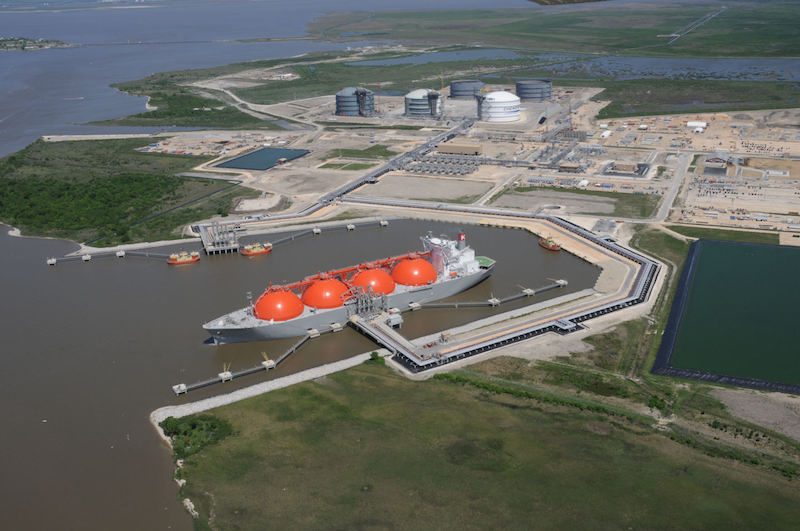Cheniere Energy’s Sabine Pass LNG Terminal. Photo credit: HDR, Inc.
By Naureen S. Malik
(Bloomberg) — Somewhere in the Gulf of Mexico right now, the Energy Atlantic is headed for Louisiana to collect an historic cargo: the first exports from America’s shale gas revolution.
Waiting to steer the giant tanker into Cheniere Energy Inc.’s $15 billion Sabine Pass terminal is a fleet of tugboats that’s spent the past seven years killing time — some days holding emergency exercises, some days racing each other. They were all set to escort shipments of natural-gas imports, but the ships never arrived: unexpectedly, the U.S. started producing enough gas of its own.
“The boats are beautiful — you could eat off the floor in the engine room,” said Richard Ennis, head of natural resources at ING Capital. With the switch to exports, the tugs will at last have a job to do — even if it’s not the one they expected. They “may actually get a scratch on them,” Ennis said.
The surge in oil and gas output from U.S. shale drillers has the potential to transform world markets. At home, it’s left a chain of idle import facilities from the Northeast to the Gulf Coast, as energy companies pile onto the export bandwagon instead: $50 billion-worth of terminals are due to come online in the next five years.
Not Needed
But if the importers were blindsided by shale, exporters now confront a glut in world markets and slowing demand in Asia that’s making some investors cautious. Cheniere’s CEO was ousted last month as shareholders rebelled against his plans to bet even more heavily on exports.
Cheniere has been able to avoid taking a financial hit on its idle import facilities because customers reserve space there even though they don’t use it. Total SA and Chevron Corp. are contracted to pay about $5 billion over 20 years to keep the tugboats, including a crew of five to seven members each, and the Sabine Pass import terminal in prime shape.
For that, each energy giant gets to reserve 1 billion cubic feet a day of re-gasification capacity — the ability to convert shipments of imported LNG into gas that could be piped around the U.S., if it was needed.
But it isn’t. Nationwide, such plants are operating at less than 1 percent of capacity. The U.S. is now producing 80 billion cubic feet a day of its own gas, and says it’s on course to become a net exporter next year.
So Cheniere and other companies — including Houston-based Freeport LNG and Dominion Resources Inc. — have been building liquefaction plants instead: facilities to turn the gas into liquid form so it can be shipped overseas.
At Sabine Pass, the import facility cost $1.6 billion, excluding financing. Liquefaction plants cost about twice that, and Cheniere plans at least five of them — making a riskier bet.
Bond markets seem to think so. Debt for the liquefaction plants traded to yield about 7.9 percent this week, some 80 basis points higher than comparable bonds for the import facility, whose costs are covered by contracts like the ones with Total and Chevron.
A key question for investors is: do the export facilities enjoy the same kind of guarantees?
Good Precedent
The import terminals “set a good precedent even though there is very very little going in,” Mihoko Manabe, senior vice president of Moody’s Investors Service in New York, said in a Dec. 15 phone interview. “We could take comfort in the fact that these contracts are being honored.”
But at least one oil major has paid up to escape a long- term contract that’s no longer needed. ConocoPhillips paid a termination fee of $522 million to Freeport as part of a deal to end its reservation of import capacity, saying it would save as much as $60 million a year.
“History is fraught with people relying on contracts to support the company” only to have “economics go the wrong way,” said Skip Aylesworth, a portfolio manager at Hennessy Funds, which holds a 4.5 percent stake in Cheniere.
“If in fact any one of the major players decides to unilaterally null and void their contract, it could cause a major revenue problem,” he said. It’s the customers who “have all the power.”
Chanos Short
At Sabine Pass, Cheniere has contracted 88 percent of the capacity for the first five liquefaction plants. That will bring annual payments of $2.9 billion for two decades once they’re all online.
For Cheniere’s former Chief Executive Charif Souki, such commitments were strong enough to press ahead with more export investments. Last summer he announced plans to boost capacity by another 50 percent — even before the first plants had come online, which they eventually did on New Year’s Eve.
By then Souki was gone. With gas prices in Asia and the U.S. near multi-year lows, shareholders had gotten nervous. Among them were some high-profile investors. Jim Chanos has said he was shorting the stock amid concerns about growing debt. Carl Icahn, who accumulated a 14 percent stake, questioned Souki’s plans. Souki was forced out last month by the board.
Shareholders wanted Cheniere, which has never posted a profit, to pay its export revenue as dividends instead of using it to fund more growth, said William Frohnhoefer, an analyst at BTIG in New York.
“Investors have said that it’s time to slow down a little bit,” he said by phone last month. Cheniere’s shares slid throughout 2015, reaching a two-year low in late December.
Souki, who’s said he’ll remain a shareholder and board member, told Bloomberg TV on Dec. 17 that “the energy business is a matter of cycles” and Cheniere will be well-placed to expand when the cycle turns again.
That may be some way off, according to Moses Rahnama, an analyst at Energy Aspects. Global LNG supply will triple by 2020 amid a “big wave” of new capacity, while demand has slowed and many buyers are trying to renegotiate contracts.
‘Just Refrigerators’
ING’s Ennis says Sabine Pass and the other export terminals under construction aren’t directly exposed to commodity-price risks.
“They are paid a capacity reservation fee regardless of what the price of gas is or how much gas goes through,” he said. “They’re just refrigerators.”
At Sabine Pass, the refrigerator is filling up — ready for the Energy Atlantic, due to arrive Tuesday to load the gas for BG Group. Empty storage tanks designed for the import terminal will be repurposed for exports, according to energy analyst Genscape Inc.
And, at last, there’ll be work for the ochre-colored tugboats with their fire-engine-red hulls. They’ll no longer be waiting for phantom ships.
©2016 Bloomberg News

 Join The Club
Join The Club











